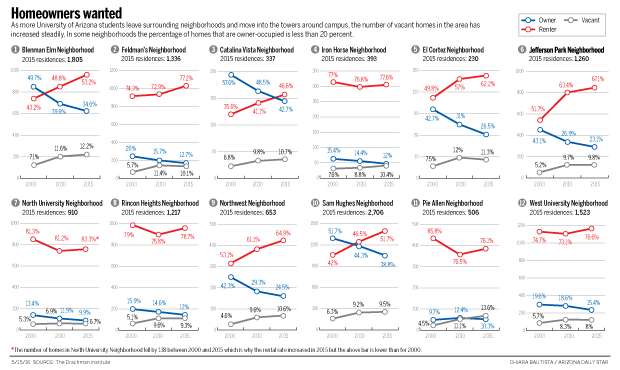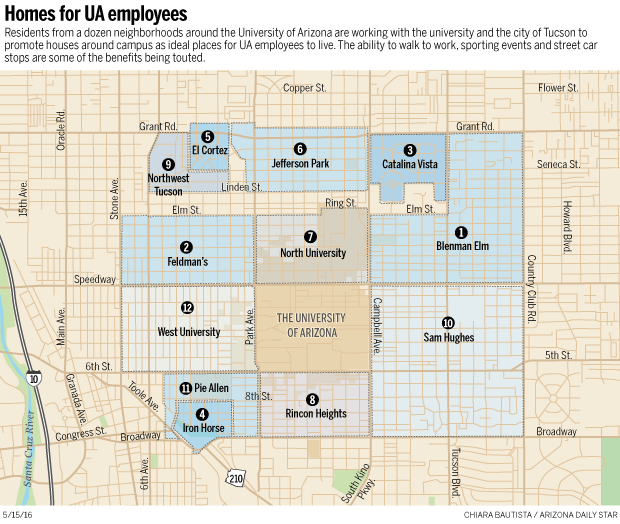Homeownership, a key indicator of neighborhood stability, has dwindled near the University of Arizona — in some cases dramatically — over the past 15 years.
In a dozen neighborhoods on the university’s borders, the rate of owner-occupied homes tops out at 42 percent and in some cases the rate is 10 percent or less.
Those rentals used to be occupied by UA students, but increasingly that group is choosing plush new student-housing communities, leaving residents to worry about vacant, unkempt properties left behind.
A new initiative to get those homes into the hands of owners is taking root, organized by the city of Tucson, the university and representatives of neighborhoods around campus.
UA employees were a natural starting place to promote a mortgage assistance program for people buying homes in the Tucson area.
“It’s important and beneficial to the community to have folks living in these neighborhoods,” said Tannya Gaxiola, UA’s assistant vice president for community relations. “We got involved with the idea of encouraging our faculty and staff to live in the surrounding neighborhoods.”
She said UA President Ann Weaver Hart and Mayor Jonathan Rothschild discussed this partnership and how other universities have undertaken similar initiatives to encourage employees to live near campus.
“We have graduate students renting and faculty and staff who are renting,” Gaxiola said. “Our role will be to promote this effort so folks are very aware of it.”
This may be the first time the UA has gotten involved in promoting homeownership around campus to its employees.
“There are examples of universities playing a role in helping turn around surrounding neighborhoods,” said Marilyn Robinson, president of the Industrial Development Authority, which is administering the mortgage loan program. “They don’t want to be sitting in the midst of degrading neighborhoods.”
Getting owners to sell
Down-payment assistance is available to qualifying homebuyers and — while not exclusive to a certain part of town — the goal is to market the funds’ availability to UA workers with a list of available properties around campus.
The mortgage loan program is funded through nearly 40 financial institutions and rolls the down payment into the monthly mortgage payments.
Buyers who get government loans and conventional loans through Freddie Mac are eligible. The home must be a primary residence and be occupied within 60 days of closing. (See box for additional information)
The mayor, who himself lives in a university-area neighborhood, is recruiting Realtors to get behind the effort.
“Homeownership creates pride in a neighborhood, which results in nicely kept communities and a reduction in crime,” Rothschild said. “Everyone benefits and the community becomes a more attractive place to live.”
Councilman Steve Kozachik, whose ward includes the majority of the 12 UA-area neighborhoods, said the city’s role can be to contact owners of vacant homes and explain the effort and remind them that tenants may be tough to find as more student housing becomes available. He hopes that the personal contact and information about the changing market could persuade the landlords to sell.
“We’ve got to do something,” he said. “People have a right to see the city has their back.”
Broken streetlights
Thirty years ago, when Diana Lett moved into the Feldman’s Neighborhood, her neighbors were her friends.
“My neighborhood was a special place, where people put down roots and stayed; where we attended the weddings, the baby showers and the funerals,” she said. Now? “I don’t even know the names of some of the kids living next door, and I doubt they know mine.”
From 2000 to 2015, the rate of owner-occupied homes in Feldman’s fell from 20 percent to 12.7 percent. The neighborhood is northwest of Speedway and Park Avenue.
Lett, who is chair of the Neighborhood Preservation Committee and alternative representative to the Campus Community Relations Committee, said she’s delighted by the new effort.
“I’ve already presented the program to our neighborhood association meeting,” she said. She will lead the effort to market Feldman’s neighborhood through social media and other outreach.
“I’d like to have neighbors who stay for years and fix up their properties, especially by planting trees to reduce the heat island effect and muffle noise,” Lett said. “I’d like it if I weren’t the only person on the block to pick up wind-blown trash, haul off abandoned televisions, call in broken streetlights, and otherwise take responsibility for the place looking halfway presentable.”
Time of Transition
In the Rincon Heights Neighborhood, southwest of Campbell Avenue and Sixth Street, the vacancy rate has nearly doubled to 9.3 percent.
“There does seem to be a lot more rent signs and they’re staying out longer,” said Colby Henley, a neighborhood association board member and representative to the Campus Community Relations Committee.
He believes student housing complexes have lured away students who would otherwise be living in his neighborhood.
“It’s a two-sided thing,” Henley said. “The towers addressed the pressure on the neighborhoods, but the flip side is it opened up some of these places and there’s more vacancies.”
He hopes professors and landscapers from the university will take a look at the neighborhood and appreciate being able to walk to work.
“Many folks think of the surrounding neighborhoods as just a bunch of college kids,” Henley said. “We’re not anti-renters or anti-students; we have great relationships with many students. It’s just so skewed and we want to reverse it.”
Robinson, of the Industrial Development Authority, said the impact of student housing was expected, “and there was bound to be a transition period.”
“The idea of filling those homes with university employees who could walk to work and cut down on traffic,” she said, “that’s just icing on the cake.”






